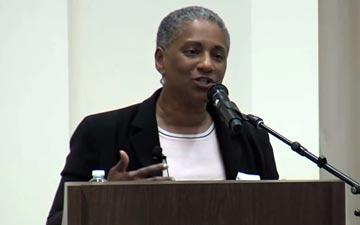Jessie Woolley-Wilson, CEO of the education technology company DreamBox, speaks about approaching diversity and inclusion as one might approach software development: through the use of an agile methodology.

A CEO’s Approach
Many companies now understand the importance of diverse workforces, but leadership can still be hesitant to move forward with diversity and inclusion efforts because they’re uncertain where to begin and whether they’ll get it wrong. On May 22, 2018, Jessie Woolley-Wilson, CEO of education technology company DreamBox, spoke at the Markkula Center for Applied Ethics about how companies can “unstick” their D&I efforts. She was then joined in conversation by Kathy Yates, former COO of MarketWatch and former COO and CEO of Teachscape.
Woolley-Wilson believes that one of the biggest hangups leaders face is fear of saying or doing the wrong thing. They don’t want to come off as sexist, racist, ageist, etc. Woolley-Wilson says one way to get out of this mindset is to acknowledge that as a leader, you’re going to get it wrong sometimes.
Woolley-Wilson approaches D&I in her organizations with an agile methodology. Agile methodology is a business approach that many tech companies have popularized over the past few decades. Software development has evolved over time: Companies start small with a minimal viable product because they have a notion that this product may work. Then they get feedback, learn, adapt, and over time, they have something viable. To quote Woolley-Wilson, “They iterate.” When it comes to D&I, people are overwhelmed by the big idea, so they do nothing. Instead, Woolley-Wilson suggests approaching D&I with an agile mindset. Leaders should be agile and root themselves in discovery; they should iterate, learn, and adapt. Woolley-Wilson has implemented this methodology in her organization, and it grounds everything they do, from D&I to product development. As a result, the company has grown rapidly since Woolley-Wilson became CEO in 2010.
Woolley-Wilson also believes that we are anchored in old notions and ways of doing D&I (like quotas and numbers); these beliefs about D&I are “calcified.” For example, a common metaphor is, “America is a melting pot.” This is a calcified notion of D&I, according to Woolley-Wilson. It implies that everyone must become the same. Instead, Woolley-Wilson says we should think of America is a quilt: We weave our diversity together to find comfort and warmth. The quilt is diversity on display, working together as one. Re-envisioning D&I can help us move forward with a new mindset, and it can help leaders re-envision their D&I programs by focusing on “big D” diversity, which she defined as diversity of thinking.
Overall, Woolley-Wilson believes that to have a diverse business, leaders should adapt to the needs of their employees and acknowledge when things go wrong. If organizations hire good people and support them, they tend to deliver good products to customers. When leaders support employees by understanding their needs and adapting, companies will have more successful cultures, and this evolution will lead to more success. Ultimately, D&I is a pathway to sustainable business, but leaders have to be willing to stick their toe in the water.
Leadership Ethics and Workplace Diversity: Interview with Jessie Woolley-Wilson
Senior Director of Leadership Ethics Ann Skeet interviews Jessie Woolley-Wilson, CEO of the education technology company DreamBox and a graduate of Harvard Business School.Topics include issues in corporate leadership, diversity, the role of the CEO, and dealing with conflict constructively and proactively.